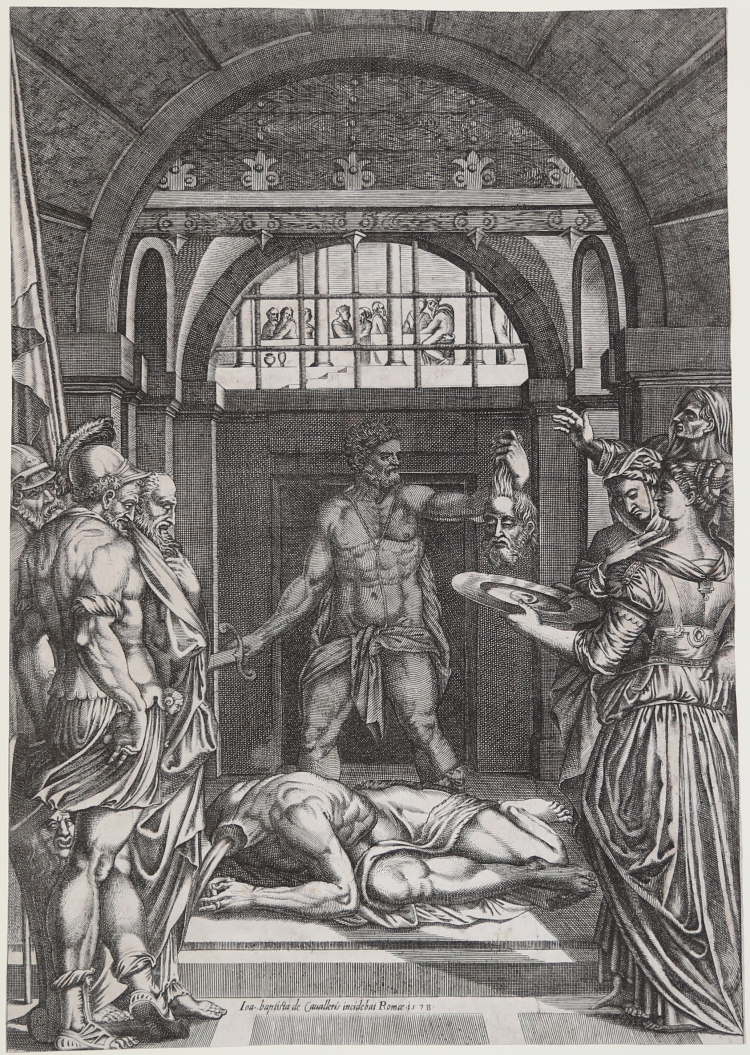



| Reference: | S30315 |
| Author | Giovanni Battista de’ CAVALIERI |
| Year: | 1578 |
| Measures: | 301 x 432 mm |


| Reference: | S30315 |
| Author | Giovanni Battista de’ CAVALIERI |
| Year: | 1578 |
| Measures: | 301 x 432 mm |
Engraving, Signed and dated lower centre: 'Ioa baptista de Cavalleris incidebat Romae 1578'. Only state
After Giorgio Vasari's altarpiece in the same direction, in the Roman church of San Giovanni Decollato,from which takes its name San Giovanni Decollato, Rome.
A great impression, printed on contemporary laid paper with "star in a cricle" watermark, trimmed to the platemark, very good condition.
Vasari’s painting has similarities of the same story by Andrea del Sarto and by Dürer. Unlike these two artists, Vasari graphically depicts the blood spurting from the arteries in the Baptist’s neck. Cranach’s woodcut may be the ultimate source for this treatment.
The scene takes place in the prison where the Baptist had been imprisoned by Herod. On either side, two rows formed to the left by soldiers, on the right from maids. Their layout / guide takes the viewer into the center of the room, where lies the body of the Baptist beheaded. His figure is emphasized by a clever use of light and shadow. The figure of the executioner, who holds in his left hand the head of the Baptist, in the act of storing it on the tray, is outlined with a very dense hatch, so as to be completely in the shade, as dark and evil figure.
|
Scorsetti, in Grafica d’Arte 49, 2002, no. 15; S. Gregory, Vasari and the Renaissance Print, p. 352.
|
Giovanni Battista de’ CAVALIERI (1525-1601)
|
Engraver,printer and print publisher,from Villa Lagarina near Trento.Active in Venice and from 1559 in Rome.1577 he had a bottega in Parione which he let out to a cartolaio,Girolamo Agnelli. His own house was in the vicolo di Palazzo Savelli, with a workshop next to it. He was the brother-in-law of Lorenzo Vaccari.
Made plates for Antonio Salamanca, Lafrery and Faleti.By 1560 he seems to have been publishing his own plates. He entered into partnerships for publishing: in 1567 with Perino Zecchini de Guarlottis and in 1576 with Lorenzo Vaccari .In 1577 he was employng a printer: Francesco Cornuti .He acquired old plates that he recut. He published plates by his contemporaries,including Cort.He himself engraved after works of many artists,including Cort.He himself engraved after works of many artists,including Francesco Salviati,Daniele da Volterra, Raphael, Michelangelo, Polidoro da Caravaggio, Livio Agresti and Baccio Bandinelli.He also made copies of earlier prints.His subject matter included the devotional topographical,antiquarian,didactic and ‘popular’.
He published a number of important series: the Pontificum Romanorum Effigies of 1580 and the Romanorum Imperatorum Effigies of 1583; the Ecclesiae Anglicanae Trophea of 1584; the Antiquarum Statuarum Urbis Romae, the first book of which was first published before 1561/2.
|
|
Scorsetti, in Grafica d’Arte 49, 2002, no. 15; S. Gregory, Vasari and the Renaissance Print, p. 352.
|
Giovanni Battista de’ CAVALIERI (1525-1601)
|
Engraver,printer and print publisher,from Villa Lagarina near Trento.Active in Venice and from 1559 in Rome.1577 he had a bottega in Parione which he let out to a cartolaio,Girolamo Agnelli. His own house was in the vicolo di Palazzo Savelli, with a workshop next to it. He was the brother-in-law of Lorenzo Vaccari.
Made plates for Antonio Salamanca, Lafrery and Faleti.By 1560 he seems to have been publishing his own plates. He entered into partnerships for publishing: in 1567 with Perino Zecchini de Guarlottis and in 1576 with Lorenzo Vaccari .In 1577 he was employng a printer: Francesco Cornuti .He acquired old plates that he recut. He published plates by his contemporaries,including Cort.He himself engraved after works of many artists,including Cort.He himself engraved after works of many artists,including Francesco Salviati,Daniele da Volterra, Raphael, Michelangelo, Polidoro da Caravaggio, Livio Agresti and Baccio Bandinelli.He also made copies of earlier prints.His subject matter included the devotional topographical,antiquarian,didactic and ‘popular’.
He published a number of important series: the Pontificum Romanorum Effigies of 1580 and the Romanorum Imperatorum Effigies of 1583; the Ecclesiae Anglicanae Trophea of 1584; the Antiquarum Statuarum Urbis Romae, the first book of which was first published before 1561/2.
|